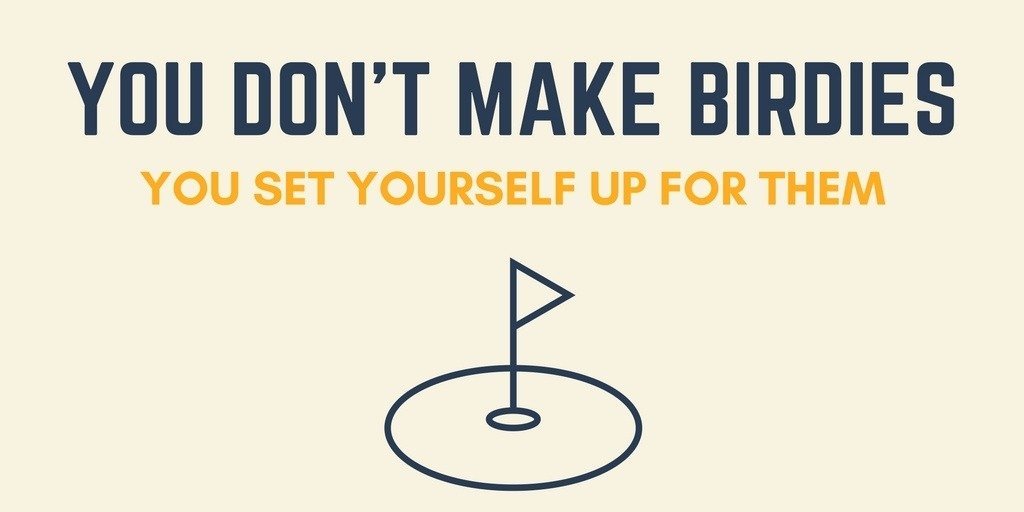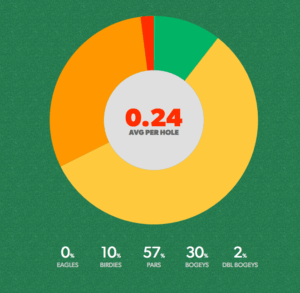
There is a terrible misconception about birdies amongst golfers that I would like to clear up. It is causing players to take unnecessary risks, and bloating their scores. If you can shift your philosophy on what a birdie represents, I believe your golf game will be better off. Simply put, you don't make birdies - you set yourself up for them.
They are not as easy as you think
The best way to manage expectations for golfers is to delve into the stats of the pros. Once you realize that the game is extremely hard for them as well, it will help put things into perspective.
I'm going to throw a few top-level stats from the PGA Tour at you.
The best player on the tour right now averages around 5 birdies per round. The middle of the pack (100 out of 200) is about 3.65. On average, tour players are making birdies roughly 15-25% of the time. This is an extraordinary number, which is what you would expect from the best players in the world.
Now let's take a look at my game. I am a scratch golfer, and you might assume that I am a birdie machine.
It turns out I'm not. Over the past 58 rounds according to GAME GOLF I am only making a birdie on 10% of my holes.

Most of them occur on par 5s, where I am averaging birdie 25% of the time.
Why is Making Birdie So Difficult?
There are a few ways to explain why making a birdie is so difficult, and why it shouldn't be your target score. I'll try to give you a few reasons why:
Putting is Quite Challenging
It's easiest to work from the green backwards to figure this out. I've discussed before how difficult putting is.
Here are make percentages of PGA Tour players from various distances:
3-5 feet – 88%
5-10 feet – 57%
10-15 feet – 33%
15-20 feet – 19%
You can safely assume that the numbers for amateur golfers are not going to be nearly as high. The takeaway is that any putt you have outside of 10 feet is likely not going in.
In order to set yourself up for a ton of birdies you will have to keep your proximity inside of 10 feet on your approach shots.
Bonus Content:Be sure to check out my complete guide to putting.
Approach Shots Are Tough Too...
Let's take a look at the average proximity to the hole from what would be considered an "easy" distance for a PGA Tour player.
From 100-125 yards you would assume that the top players in the world are painting pins, and leaving themselves plenty of putts inside of 10 feet for birdie.
Currently the best proximity to the hole is 15' 3" from Scott Stallings. If you go to 100th out of 200th on tour you get an average of 20 feet. The lowest performing player is around 30 feet.
Most players are leaving themselves putts from outside of 20 feet, which means their chances of making them are less than 1 in 5. That's only from a shorter distance.
If you go back to approaches from 150-175 yards most players are leaving themselves putts longer than 25 feet.
So Where Are All the Birdies Coming From?
The majority of players on tour are making their birdies on par 5s. The average score for almost every player on tour is under par for those holes.
On par 4s and par 3s most players are averaging above par, and only a select few barely average a score better than par.
You Can't Force Them...
Hopefully I have painted a clear picture for you at this point. Making birdies is incredibly difficult because it takes a combination of marksmanship with your approach shots, and excellent putting. Additionally, you have to keep your tee shots in play to even have a chance of hitting a green in regulation.
If you are entering a hole with birdie in your crosshairs I believe you are making a huge mistake. The real key to golf at almost any level is avoiding scores over par. Depending on what level you are playing, it could be bogeys, or double bogeys (and worse).
This is essentially how Tiger Woods outlasted fields. He made sure that he never made unnecessary mistakes on par 3s and par 4s. He mostly strategized so that his approach shots were on the fat sides of greens, and when birdies dropped it was a bonus. Then he used his length and accuracy to make a disproportionate amount of birdies on par 5s. Players who felt the pressure to catch up with him had to play aggressively, and eventually made mistakes.
If you are trying to make a birdie, that means you are being needlessly aggressive. You might choose a club or target off the tee that offers a large reward, but brings plenty of risk into play. Additionally, if a pin is tucked near trouble, and you miss on the short side of the green, you are almost guaranteeing yourself a bogey.
They Just Happen
The honest truth for most of you reading this is that birdie should not really be part of your vocabulary. If you are playing golf for a living, they are an absolute necessity to keep making a paycheck. However, if you are just looking to break 80, 90, or 100 - they are not necessary.
You can put yourself in a position to make a birdie through smart strategic play, and good ball striking. Since putting is so difficult, a certain percentage of those putts will fall in the hole over time. For the most part, accepting your two-putt par should be more than OK for you.
If you are putting pressure on yourself to make birdies during your rounds I strongly urge you to stop doing it. This added stress you are putting on your strategy and execution is likely going to result in more bogeys and double bogeys. Those are the scores that really stunt your progress in golf.
Long story short - you can't make birdies in my opinion. All you can do it set yourself up for them.
We care about the protection of your data Read our Privacy Policy